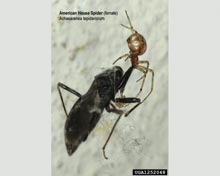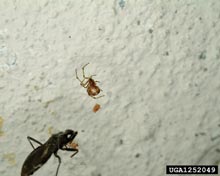
Joseph Berger

Joseph Berger
Cobweb Spiders
General Description
The bulbous abdomen and much smaller head section of the cobweb spider gives it a characteristic spider
shape. The group includes many medium-size species with bodies up to one-half of an inch long that are black to
brown in color with various patterns and markings.
Cobweb spiders are also known as comb-footed spiders because of comb-like bristles on the last segments of
their hind legs, which are used to wrap prey. These spiders hang in irregularly shaped webs that are usually
positioned close to the floor in moist crawlspaces, basements and garages. If one web is unproductive, the spider
will build another nearby, leaving the old web to gather dust and become a “cobweb.” Widow spiders, such as the
black widow (Latrodectus mactans), are cobweb spiders with bites that can be dangerous. But while the cobweb
spiders typically found in homes may resemble widow spiders, their bites are not dangerous.
General Control
Controlling cobweb spiders begins with inspecting structures and yards for the presence of the spiders and their
webs. These spiders can be dispatched by vacuuming, if care is taken not to release them when emptying the
vacuum cleaner. Smashing them with fly swatters, boards and shoes will work, as the spiders are not aggressive
and cannot run away fast. Treating them directly with a contact pesticide is another option. Lastly, applications of
residual pesticides, such as wettable powders or encapsulates, to crawlspaces and around foundations also can
deter these and other types of spiders.









